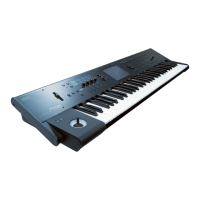Installation guide
4
Installing the KORG USB-MIDI driver
and the editor software in Mac OS X
Installing the software
You’ll need to run the installer separately for each
software item such as the KORG USB-MIDI driver and
M50 Editor/Plug-In Editor to install them one at a
time.
1. Insert the included CD-ROM into the CD-ROM
drive of your computer.
2. In the CD-ROM, double-click the software
installer (.pkg) to start up the installer.
Each installer is located in the following folder.
• KORG USB-MIDI driver
“KORG USB-MIDI DRIVER” folder
→
KORG USB-
MIDI DRIVER.pkg
• M50 Editor
“M50 Editor” folder
→
M50 Editor.pkg
3. Follow the on-screen instructions to install each
item of software such as the KORG USB-MIDI
driver and M50 Editor.
Note:
If you intend to use M50 and computer via the
USB port, you’ll need to install the KORG USB-MIDI
driver on your computer.
4. When you’ve finished installing the software, exit
the installer.
Setting up the M50 Editor/Plug-In Editor
For details on setting up the M50 Editor/Plug-In
Editor, please see “M50 Editor/Plug-In Editor
Manual” (PDF).
About the M50 and USB-MIDI driver ports
KEYBOARD port
Applications on your computer use this port to receive
MIDI messages from the M50 (data from the keyboard
and controllers).
SOUND port
Applications on your computer use this port to send
MIDI messages to the M50’s internal sound generator,
making it produce sound.
Connecting a computer
USB connection and setup
Note:
The USB connector of the M50 is only able to
transmit and receive MIDI data.
Before you connect the M50 to your computer via
USB, you must install the KORG USB-MIDI driver
in your computer. If you’re using Windows, you’ll
need to install the driver for each USB port you
use. If you connect the M50 to a USB port other
than the one you used when installing the KORG
USB-MIDI driver, you’ll need to install the driver
again. For details, please see “Installing the driver
and the editor software in Windows” on page 2.
1. Using a USB cable, connect the USB connector of
the M50 to the USB connector of your computer.
2. Make the necessary settings in the M50’s Global
mode.
For details, please see “Global mode settings on the
M50” on page 5.
3. Make the necessary settings on your computer.
For details, please see “M50 Editor/Plug-In Editor
Manual” (PDF).
Using the M50 Editor/Plug-In Editor via a USB
connection
If you want to mix the M50’s audio signals with the
audio signals sent from your host application via your
audio interface, or with audio signals from another
sound module, make connections as shown below.
Computer
M50
USB cable
USB
INPUTINPUT
AUDIO OUTPUT
R
L/MONO
INPUTINPUT
M50
USB
USB
Computer
Audio interface
Powered
monitors
M50’s audio signals
MIDI signals
Other audio signals

